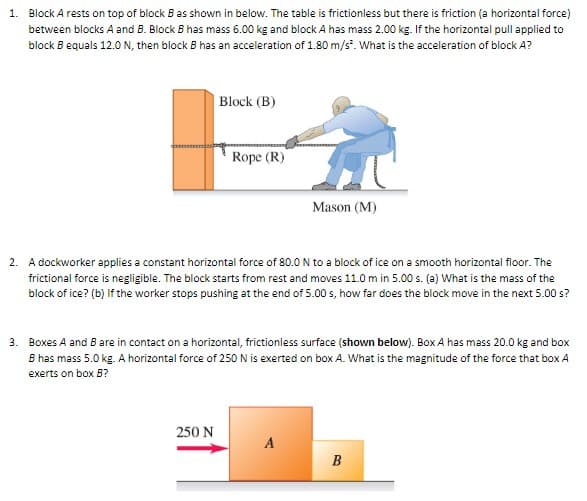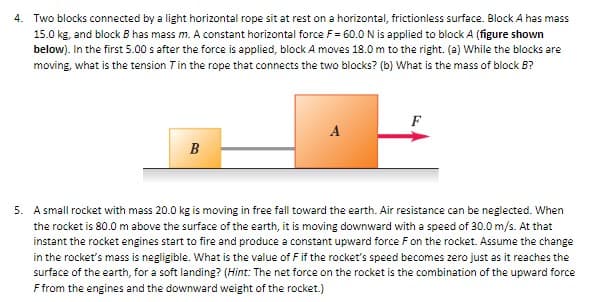1. Block A rests on top of block B as shown in below. The table is frictionless but there is friction (a horizontal force) between blocks A and B. Block B has mass 6.00 kg and block A has mass 2.00 kg. If the horizontal pull applied to block B equals 12.0 N, then block B has an acceleration of 1.80 m/s². What is the acceleration of block A? Block (B) Mason (M) Rope (R)
1. Block A rests on top of block B as shown in below. The table is frictionless but there is friction (a horizontal force) between blocks A and B. Block B has mass 6.00 kg and block A has mass 2.00 kg. If the horizontal pull applied to block B equals 12.0 N, then block B has an acceleration of 1.80 m/s². What is the acceleration of block A? Block (B) Mason (M) Rope (R)
College Physics
10th Edition
ISBN:9781285737027
Author:Raymond A. Serway, Chris Vuille
Publisher:Raymond A. Serway, Chris Vuille
Chapter4: The Laws Of Motion
Section: Chapter Questions
Problem 7WUE: Calculate the normal force on a 15.0 kg block in the following circumstances: (a) The block is...
Related questions
Topic Video
Question
1.Block A rests on top of block B as shown in below. Thetable is frictionless but there is friction (a horizontal force) betweenblocks A and B. Block B has mass 6.00 kg and block A has mass 2.00 kg.If the horizontal pull applied to block B equals 12.0 N, then block B hasan acceleration of 1.80 m/s2. What is the acceleration of block A?
2.A dockworker applies a constant horizontal force of 80.0 N toa block of ice on a smooth horizontal floor. The frictional force is negligible.The block starts from rest and moves 11.0 m in 5.00 s. (a) What isthe mass of the block of ice? (b) If the worker stops pushing at the endof 5.00 s, how far does the block move in the next 5.00 s?
3.Boxes A and B are incontact on a horizontal, frictionlesssurface (shown below). Box A hasmass 20.0 kg and box B has mass 5.0 kg. A horizontal force of 250 Nis exerted on box A. What is themagnitude of the force that box Aexerts on box B?
4.Two blocks connected by a light horizontal rope sit at reston a horizontal, frictionless surface. Block A has mass 15.0 kg, andblock B has mass m. A constant horizontal force F = 60.0 N is appliedto block A (figure shown below). In the first 5.00 s after the force is applied,block A moves 18.0 m to the right. (a) While the blocks are moving,what is the tension T in the rope that connects the two blocks? (b) Whatis the mass of block B?
5.A small rocket with mass 20.0 kg is moving in free falltoward the earth. Air resistance can be neglected. When the rocket is80.0 m above the surface of the earth, it is moving downward with aspeed of 30.0 m/s. At that instant the rocket engines start to fire and producea constant upward force F on the rocket. Assume the change in therocket’s mass is negligible. What is the value of F if the rocket’s speedbecomes zero just as it reaches the surface of the earth, for a soft landing?(Hint: The net force on the rocket is the combination of the upwardforce F from the engines and the downward weight of the rocket.)

Transcribed Image Text:1. Block A rests on top of block B as shown in below. The table is frictionless but there is friction (a horizontal force)
between blocks A and B. Block B has mass 6.00 kg and block A has mass 2.00 kg. If the horizontal pull applied to
block B equals 12.0 N, then block B has an acceleration of 1.80 m/s². What is the acceleration of block A?
Block (B)
Rope (R)
Mason (M)
2. A dockworker applies a constant horizontal force of 80.0 N to a block of ice on a smooth horizontal floor. The
frictional force is negligible. The block starts from rest and moves 11.0 m in 5.00 s. (a) What is the mass of the
block of ice? (b) If the worker stops pushing at the end of 5.00 s, how far does the block move in the next 5.00 s?
3. Boxes A and B are in contact on a horizontal, frictionless surface (shown below). Box A has mass 20.0 kg and box
B has mass 5.0 kg. A horizontal force of 250 N is exerted on box A. What is the magnitude of the force that box A
exerts on box B?
250 N
A
B

Transcribed Image Text:4. Two blocks connected by a light horizontal rope sit at rest on a horizontal, frictionless surface. Block A has mass
15.0 kg, and block B has mass m. A constant horizontal force F= 60.0 N is applied to block A (figure shown
below). In the first 5.00 s after the force is applied, block A moves 18.0 m to the right. (a) While the blocks are
moving, what is the tension 7 in the rope that connects the two blocks? (b) What is the mass of block B?
F
A
B
5. A small rocket with mass 20.0 kg is moving in free fall toward the earth. Air resistance can be neglected. When
the rocket is 80.0 m above the surface of the earth, it is moving downward with a speed of 30.0 m/s. At that
instant the rocket engines start to fire and produce a constant upward force F on the rocket. Assume the change
in the rocket's mass is negligible. What is the value of F if the rocket's speed becomes zero just as it reaches the
surface of the earth, for a soft landing? (Hint: The net force on the rocket is the combination of the upward force
F from the engines and the downward weight of the rocket.)
Expert Solution
This question has been solved!
Explore an expertly crafted, step-by-step solution for a thorough understanding of key concepts.
This is a popular solution!
Trending now
This is a popular solution!
Step by step
Solved in 4 steps with 4 images

Knowledge Booster
Learn more about
Need a deep-dive on the concept behind this application? Look no further. Learn more about this topic, physics and related others by exploring similar questions and additional content below.Recommended textbooks for you

College Physics
Physics
ISBN:
9781285737027
Author:
Raymond A. Serway, Chris Vuille
Publisher:
Cengage Learning

Principles of Physics: A Calculus-Based Text
Physics
ISBN:
9781133104261
Author:
Raymond A. Serway, John W. Jewett
Publisher:
Cengage Learning

Physics for Scientists and Engineers with Modern …
Physics
ISBN:
9781337553292
Author:
Raymond A. Serway, John W. Jewett
Publisher:
Cengage Learning

College Physics
Physics
ISBN:
9781285737027
Author:
Raymond A. Serway, Chris Vuille
Publisher:
Cengage Learning

Principles of Physics: A Calculus-Based Text
Physics
ISBN:
9781133104261
Author:
Raymond A. Serway, John W. Jewett
Publisher:
Cengage Learning

Physics for Scientists and Engineers with Modern …
Physics
ISBN:
9781337553292
Author:
Raymond A. Serway, John W. Jewett
Publisher:
Cengage Learning

Physics for Scientists and Engineers
Physics
ISBN:
9781337553278
Author:
Raymond A. Serway, John W. Jewett
Publisher:
Cengage Learning

Physics for Scientists and Engineers, Technology …
Physics
ISBN:
9781305116399
Author:
Raymond A. Serway, John W. Jewett
Publisher:
Cengage Learning

College Physics
Physics
ISBN:
9781305952300
Author:
Raymond A. Serway, Chris Vuille
Publisher:
Cengage Learning